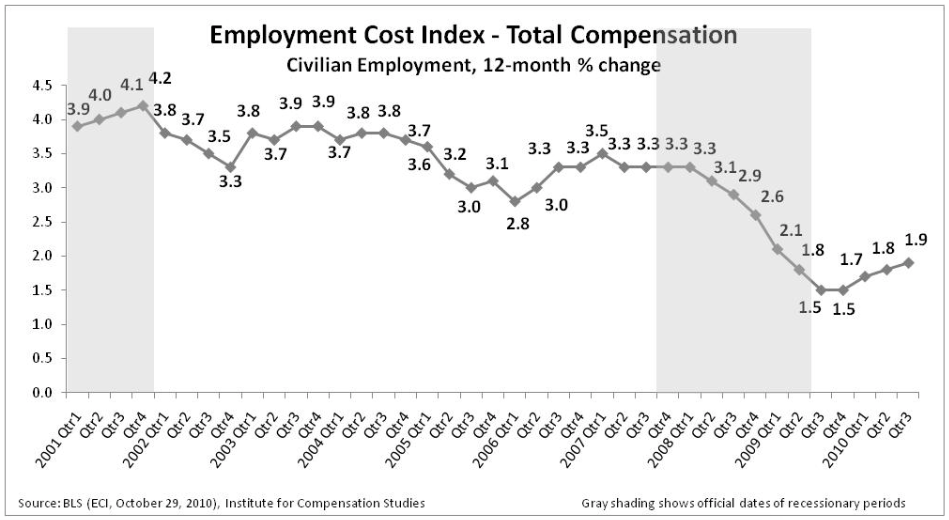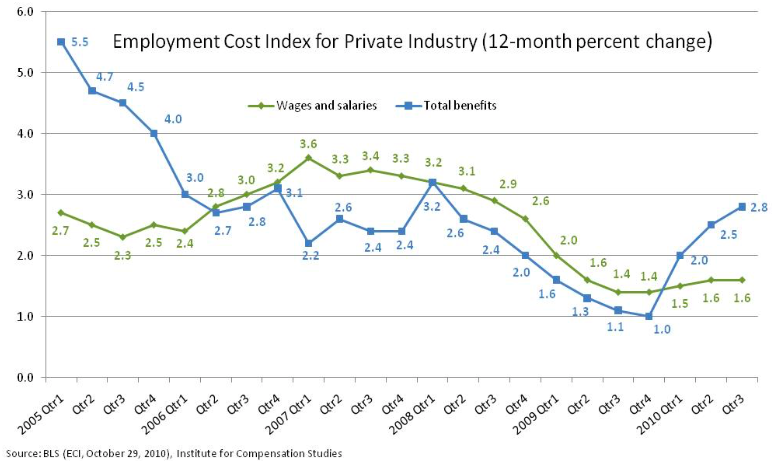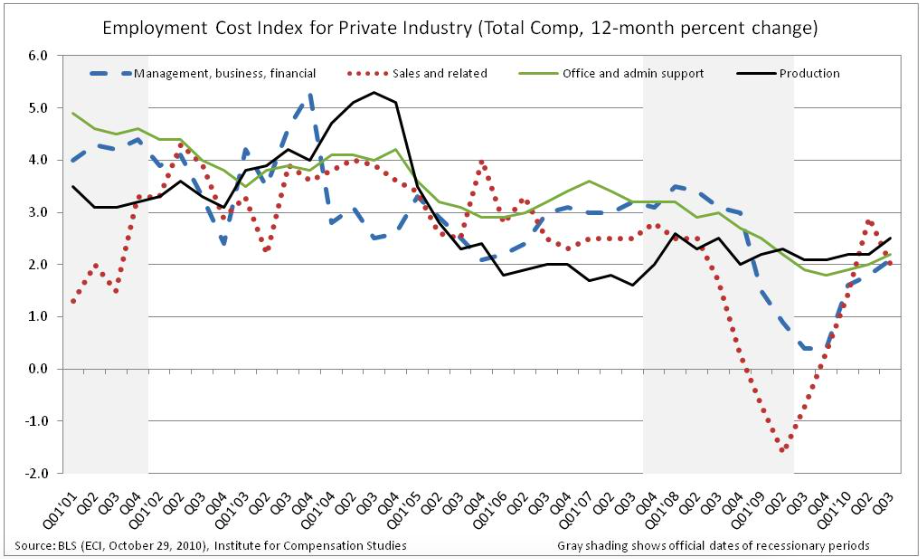2010 Third Quarter
Latest ECI figures reveal labor market “anemic”; private-sector employees faring better
Growth rates of U.S. employment costs for the third quarter of 2010 provide further evidence of a soft, but non-recessionary private-sector labor market. The state and local public-sector labor market continues to struggle.
Employer spending on total employee compensation across the civilian labor force (which includes private and public sectors) rose almost two percent over a year ago (1.9 percent for the 12 months ending September 2010), according to the Employment Cost Index released Friday by the U.S. Bureau of Labor Statistics. This 12-month percent change is up slightly from the 1.8 percent reported in the previous quarter, but well below pre-recession levels of 3 to 4 percent. Inflation (CPI-U) currently stands at 1.1 percent.1
During the past 12 months, the Consumer Price Index for All Urban Consumers index increased 1.1 percent before seasonal adjustment. See Consumer Price Index – September 2010, http://www.bls.gov/cpi/

This quarter’s small uptick in the Employment Cost Index is due to accelerating spending by employers on benefits costs, rather than wages and salaries. Employer spending on wages and salaries, while still higher than a year ago, decelerated in the third quarter.
The wage and salary costs for the civilian labor force (private and public) are 1.5 percent higher than a year ago. This is a slightly slower growth rate than the 1.6 percent rate recorded for the 12 months ending in June 2010.
Contrast this to the employer spending for employee benefit costs. Employers across the civilian labor force (private and public) spent 2.7 percent more on employee benefits for the 12 months ending September 2010, compared to 2.5 percent more reported in the second quarter for the 12 months ending June 2010.

In net, the 12-month percent change in wages and salaries fell, while the 12-month percent change in employment costs for benefits rose. The combined effect was a slight increase in the year-on-year growth rate of total compensation costs to employers across the labor force.
No Relief for State and Local Government Workers
Public sector employees are carrying the burden of the deceleration of wage and salary increases. Combating budget woes, local and state governments lowered, on net, the wage and salary levels over the past quarter (down -0.3 percent, seasonally adjusted). Wages and salaries are now just 1.1 percent above where they were one year ago.

This is down notably from year-on-year growth recorded in the previous quarter. Wages and salaries had been up 1.4 percent over the 12 months ending June 2010.
A slight increase in the reported 12-month percent change in benefits costs (from 2.6 in Q2 to 2.7 in Q3) moderated a bit the steep slowdown of wage and salary increases. In net, growth in total employment compensation costs for state and local government employees has decelerated from 1.8 percent to 1.7 percent, year-on-year.
Employment Losses Continue to Weaken Public Sector Labor Market
The employment situation of the public and private sectors underpins the current employment compensation trends. Private employment began adding jobs in the beginning of 2009. State and local governments, on the other hand, continue to shed workers as month-over-month changes in state and local employment levels remain in the negative.

Some Wage and Salary Action in Private Sector
Consistent with a labor market that is anemic, but still trending toward improvement, the 12- month percent change of wages and salaries in the private sector is holding flat. Identical to the second quarter, private sector employer expenditures on wages and salaries are up 1.6 percent for the 12 months ending September 2010.

Within the private sector, however, there is some notable variation in employment cost increases across occupations. Sales occupations experienced the biggest recessionary roller coaster rebound as of the second quarter of 2010, among job categories tracked by the Employment Cost Index. Sales had the strongest acceleration in total compensation for the 12 months ending June 2010 at 2.9 percent, after total compensation contractions year-on-year as large as -1.6 percent for the 12 months ending June 2009. This quarter, the rebound in sales is a bit softer, while still at the higher end of the range. Occupations in production/transportation/moving materials and office/administration currently show slightly stronger growth in total compensation for the 12 months ending September 2010 (2.5 and 2.2 percent, respectively).

Employment costs for management/business/financial occupations are still on the upswing, having registered the second largest drop and rebound of this recession. After bottoming out to almost a standstill (0.4 percent in Q3 AND Q4 2009), the 12 month percent increase in total compensation for those in management/business/financial jobs is 2.1% as of September. This is an increase from the 1.8 percent year-on-year increase for the 12 months ending June 2010.



